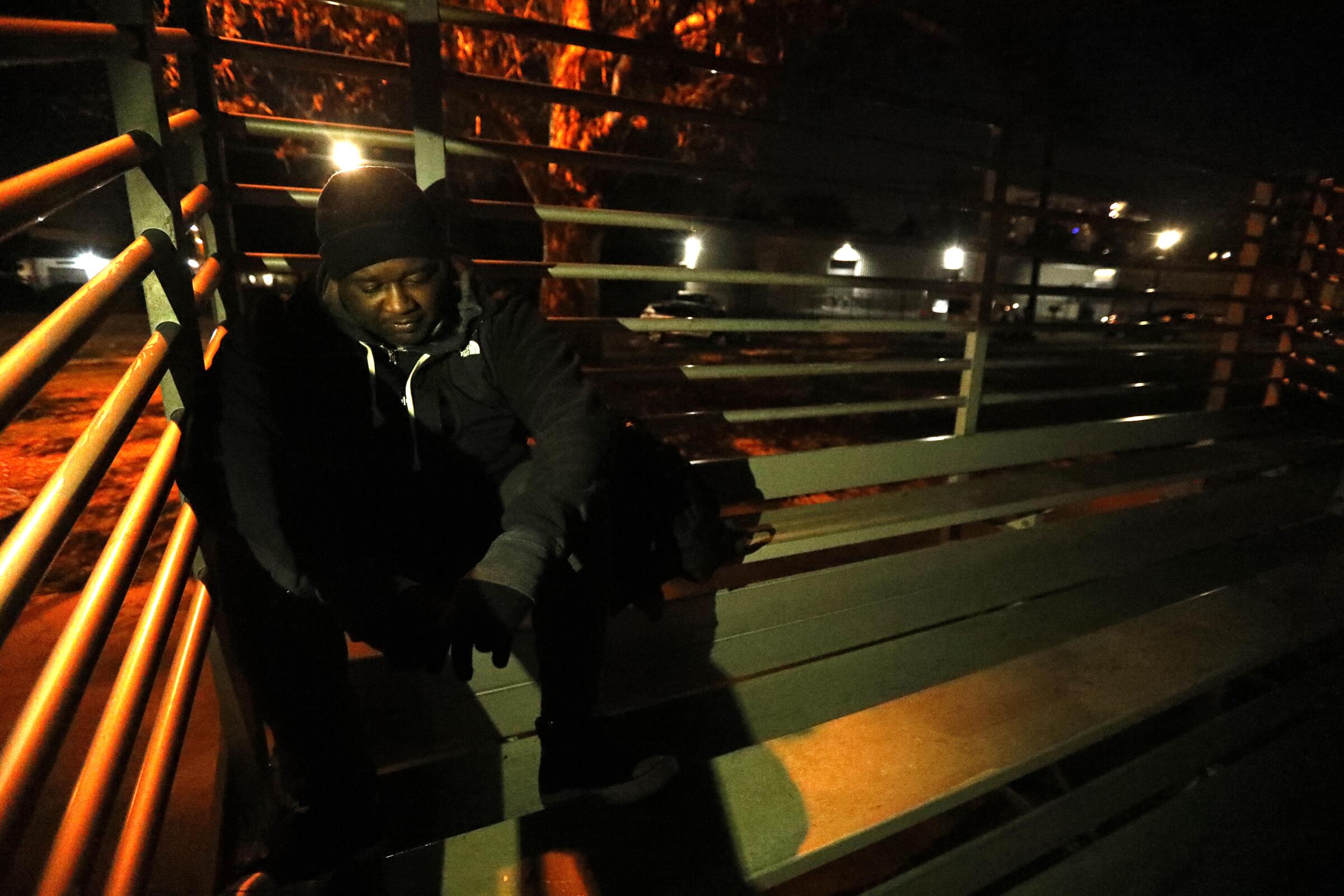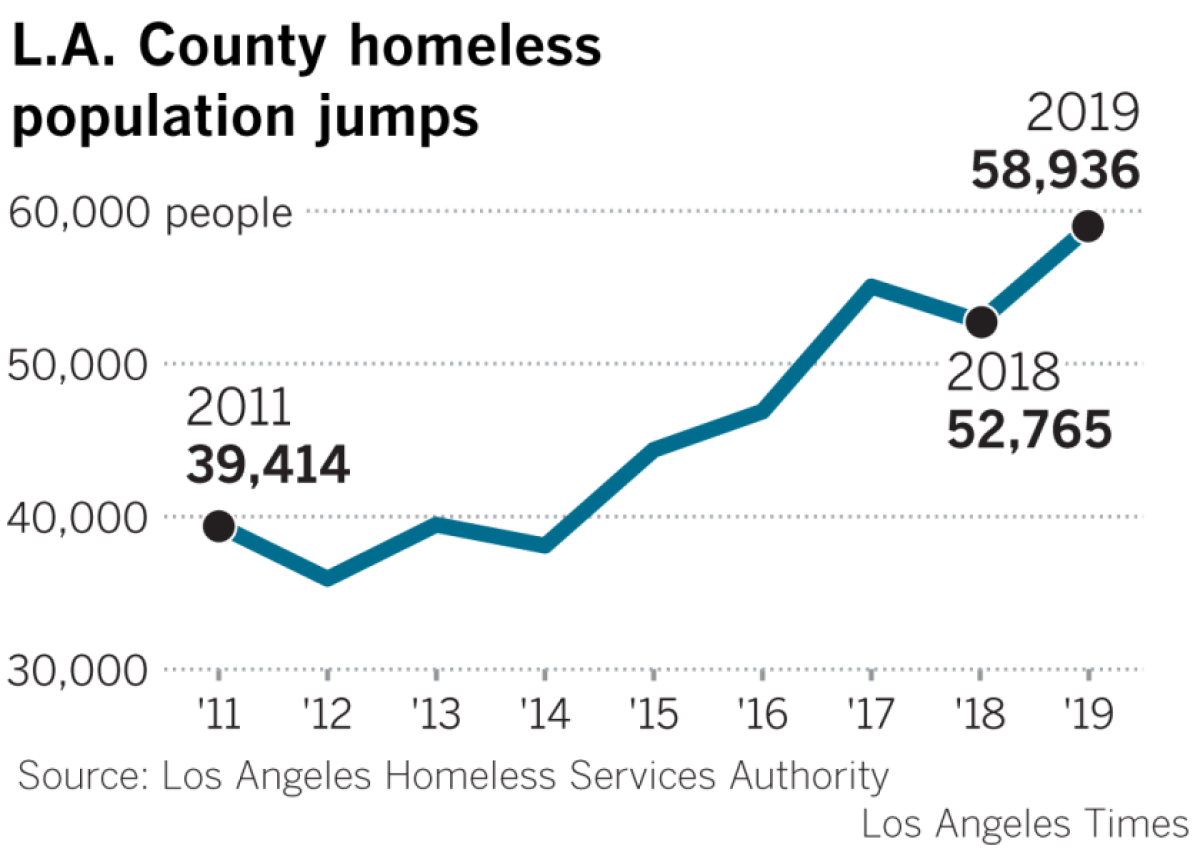Start your day right
Sign up for Essential California for news, features and recommendations from the L.A. Times and beyond in your inbox six days a week.
You may occasionally receive promotional content from the Los Angeles Times.

On Tuesday evening, Los Angeles County will begin its annual, three-day “point in time” count of the homeless population.
Thousands of volunteers will fan out with clipboards across the city to get a snapshot of the county’s sheltered and unsheltered homeless population — one of the largest in the country.
The results normally get released in May or June, and are used by government officials to determine funding priorities for housing and services, and by the public to assess how much progress has been made on stemming the tide of homelessness.
Here’s what you need to know.
Estimating the county’s homeless population is no small feat. The count takes place over several days.
It starts Tuesday in the San Gabriel and San Fernando valleys. On Wednesday, it picks up in West Los Angeles, Southeast Los Angeles and the South Bay. And finally, on Thursday volunteers canvass the Antelope Valley, Metro Los Angeles and South Los Angeles.
With the exception of the Antelope Valley, where volunteers go out early in the morning, the count takes place late at night in the county’s roughly 2,160 census tracts. Last year, there were nearly 8,000 RSVPs to volunteer, according to the Los Angeles Homeless Services Authority.
PHOTOS: 2020 Greater Los Angeles Homeless Count
In places that are tougher or more dangerous for volunteers to reach, such as in riverbeds and alleys, the Los Angeles County Sheriff’s Department helps out.
In all, the whole three-day exercise costs about $1.1 million, according to the homeless authority, which oversees the count.
You can still sign up here.
The results aren’t just something for politicians to celebrate or worry about come election time. Real dollars are tied to how many people volunteers find living on the street. The federal government divvies up resources based on these numbers, giving the places with the most homeless people the most resources.
The 2019 count found 58,936 homeless people living in Los Angeles County and 36,300 living in the city of Los Angeles. Those were increases of 12% and 16%, respectively, over 2018. The 2018 count found that Los Angeles County had 52,765 homeless people, which was a slight dip from the year before. In the city of Los Angeles, there were 31,285 homeless people that year.

Well they didn’t. This number is an estimate, and some critics ding the county’s number crunchers for their implied precision. After volunteers go out, the records are sent to the Los Angeles Homeless Services Authority, which uses them to create statistical estimates by weighting the volunteers’ observations with results gleaned from their survey of homeless people. Separately, workers survey thousands of homeless people to come up with estimates of how many people live in each car, lean-to and tent.
But using a different analysis of the survey, a local nonprofit estimated that 102,278 became homeless at one time or another during 2017.
It’s not easy to identify a single reason why the homeless population has climbed, but there are some key factors. L.A.’s red-hot housing market has made it difficult for people already living on the edge of poverty to continue to afford their rent. Many of them have been forced into the streets.
Government officials also have struggled to keep up. The city and county have launched various programs to add affordable housing units, temporary shelter beds and permanent supportive housing. But construction has been slow and was often met with backlash from residents.
Last year, the Westside experienced the largest increase at 19%, following a year in which its numbers were down by even more. The San Gabriel Valley was close behind with a 17% increase, marking the second consecutive year its homeless population had grown. South Los Angeles also saw a jump of 15%.
Well, no, actually. The homeless authority reports that the majority of the homeless people have lived in Los Angeles County for 10 years or longer. About 75% of the homeless adults and children in so-called adult families (in which there’s at least one adult older than 24) said they had lived somewhere in Southern California before becoming homeless.
Money is beginning to flow from the city and county into services programs and permanent housing and shelter projects. Los Angeles spent $619 million 2018 on homelessness.
Mayor Eric Garcetti declared a shelter crisis in 2018 and created the “A Bridge Home” program with the goal of placing at least one temporary shelter in each City Council district. So far, at least nine shelters have opened with a combined 519 beds. In all, 30 shelters are in some stage of development for a total of 2,300 new beds, including about 900 that the city plans to fund from other sources.
However, many council members have been slow to follow through on their promise to build at least 222 units of supportive housing in each district by July 1, 2020. While some have exceeded the goal, others have not.
This month, the city opened its first homeless housing development, funded by Proposition HHH, the $1.2-billion bond measure passed in 2016. About 20 more projects are under construction. Work will begin on an additional 30 in 2020.
The state has also committed to spending millions of dollars to help cities and counties address the crisis. In his most recent budget proposal, Gov. Gavin Newsom asked the Legislature for more than $1.4 billion, with much of the money earmarked as subsidies for immediate housing and community healthcare services.
Start your day right
Sign up for Essential California for news, features and recommendations from the L.A. Times and beyond in your inbox six days a week.
You may occasionally receive promotional content from the Los Angeles Times.